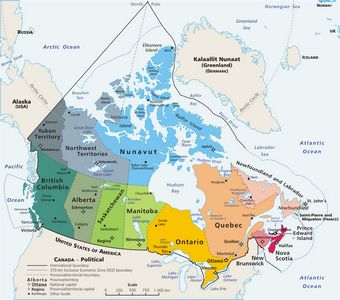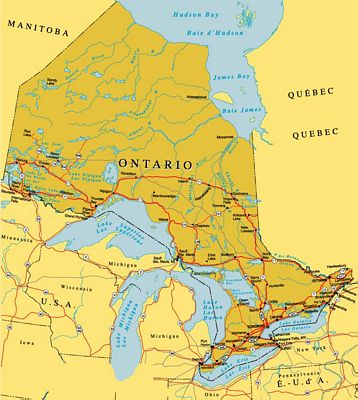Canada's land area is 9,970,610 km2 which is the second largest country in the world. It is a federation which consists of ten provinces and three territories. The provinces are Alberta, British Columbia, Manitoba, New Brunswick, Newfoundland and Labrador, Nova Scotia, Ontario, Prince Edward Island, Quebec, and Saskatchewan. The three territories are Northwest Territories, Nunavut, and Yukon.Its geographical extension has occupied over six time zones. Ottawa is the Capital of Canada which is located in Ontario. Canada has 10 provinces and 3 territories. The National emblem is the maple leaf which is found in the middle of the National Flag. The population in Canada in April 2007 is estimated at 32,852,800. The largest city in Canada is Toronto followed by Montreal, Vancouver, Ottawa-Hull, and Edmonton. About 31 percent of the population live in the largest cities of Toronto, Montreal and Vancouver. Canada is a multi-national and multi-cultural country with different ethnic groups including British, French, German, Italian, Ukrainian, Dutch, Polish, Chinese, South Asian, Jewish, West Indian, Portuguese and Scandinavian.

Map showing the boundary of Canada in North America (Source: www.wikipedia.com)
|
|
Ontario is Canada's second largest province, covering more than one million square kilometers. The province is bounded by Quebec on the east, Manitoba on the west, Hudson Bay and James Bay on the north, and the St. Lawrence River and the Great Lakes on the south. Ontario's landforms are the products of continental uplift and erosion, the movement of glaciers, and the continuing actions of wind, waves, water and gravity. Niagara Falls is a world-famous tourist destination, attracting 18 million visitors a year.

Map showing the Ontario province (Source: http://www.ontariooutdoor.com/en/map_ontario.html)
|
|
Toronto - the name derived from the Huron word for "fishing weir" - is on the northwest shore of Lake Ontario. Toronto covers 641 km2. and stretches 43 km from east to west and 21 km from north to south at its longest points. Toronto is Canada's largest city, the heart of the nation's commercial, financial, industrial, and cultural life, and is one of the world's most liveable urban centres. Toronto is also the home of the world's tallest building (CN Tower at 553.33 m) as well as the world's longest street starts at the City's lakeshore (Yonge Street at 1,896 km).

The CN Tour in Toronto, Canada
|
|
Kitchener-Waterloo is located in the Region of Waterloo, in the heart of southwestern Ontario. Kitchener was originally known as Berlin (reflecting its Mennonite and German origins) but was renamed for Field Marshall Lord Horatio Kitchener in 1916 at the height of World War I. Waterloo was named after a place just south of Brussels, Belgium, where the Allied armies, under the British and Prussian commanders, defeated Napoleon and the French army in 1815. The two cities which are always named as Twin Cities (KW), have a population of 277,000. The area is referred to as Canada's Technology Triangle, because it is defined by an exceptional business base, a diversity of industry, world-class educational institutions and its history of technological innovation.

Overview of the Kitchener-Waterloo Twin Cities
|
|
|